Prominent environmental lawyer Mahesh Chandra Mehta presented images of the Taj Mahal to the supreme court justices, and said the government views the UNESCO heritage listed site as a money making machine.
Justices Madan B. Lokur and Deepak Gupta examined images presented by the activist and agreed the almost 400-year-old monument is not being properly maintained. The images are said to show the Taj’s transition from its original pristine white shade to its current discoloured state, and prompted the court to ask whether the government is unable or simply, unwilling to preserve the marble mausoleum.
The images are said to show the Taj’s transition from its original pristine white shade to its current discoloured state, and prompted the court to ask whether the government is unable or simply, unwilling to preserve the marble mausoleum.

Pollution has discoloured the Taj Mahal, and some parts of the marble have corroded Source: Pallava Bagla / Getty
Mr Mehta first filed a petition to draw the court's attention to the deterioration of the mausoleum 34 years ago, and the open court session held this week is part of the court's ongoing monitoring of the situation.
Mr Mehta has a reputation as a tireless environmental crusader, and rose to prominence decades ago, when during a case regarding water pollution, he asked the defense counsel to drink a sample of the discoloured water, compelling the court to close five factories.
“Even if you have the expertise, you are not utilising it,” the court said to government law officers.
"It was first becoming yellow, now it seems to be green and black...Perhaps you do not care."
The court noted that as the government still gives foreign visitors tours of the iconic site, it should be more involved in its upkeep. “The photographs show a lack of will. When was the last time you visited the Taj?” Justice Lokur asked the government lawyers, to which they responded it had been over a decade.
“The photographs show a lack of will. When was the last time you visited the Taj?” Justice Lokur asked the government lawyers, to which they responded it had been over a decade.

Prime Minister of Canada Justin Trudeau, his wife Sophie Gregoire and their children pose for a photograph during their visit to Taj Mahal in Agra on February 1 Source: Money Sharma / Getty
The court ordered the government hire experts from abroad, if they cannot find specialists within India who can help turn around the monument's deterioration.
The Taj Mahal sites by the Yamuna River in Agra, is significant for many Indians, who once believed a dip in those very waters could cure them of ailments. But, according to a 2015 report by India’s Central Water Commission, the “contamination level is irreversible, water is unusable both for irrigation and drinking”.
But, according to a 2015 report by India’s Central Water Commission, the “contamination level is irreversible, water is unusable both for irrigation and drinking”.

Waste Material in Yamuna River Source: Ramesh Lalwani / Getty
The polluted water is said to be drawing bugs, which are adding to the discolouration of the building. The controversy comes in the early stages of the government’s controversial Adopt a Heritage initiative, a scheme which allows corporations to take over the management of historic sites for five years, through a process of open bidding.
The controversy comes in the early stages of the government’s controversial Adopt a Heritage initiative, a scheme which allows corporations to take over the management of historic sites for five years, through a process of open bidding.

Insects are said to be adding to the discolouration of the monument Source: Archaeological Survey of India
The program allows companies to put up advertising, and set ticket prices within the monuments, and the government describes it as “a unique opportunity to attach your name to India’s heritage.”
Two major conglomerates are reportedly in the midst of a bidding war for the Taj Mahal, which was commissioned in 1631 and built over a period of 20 years.
The next Supreme Court regarding the Taj Mahal hearing is set for May 9.
SBS News has contacted Mr Mehta’s environmental foundation for comment.
Share


